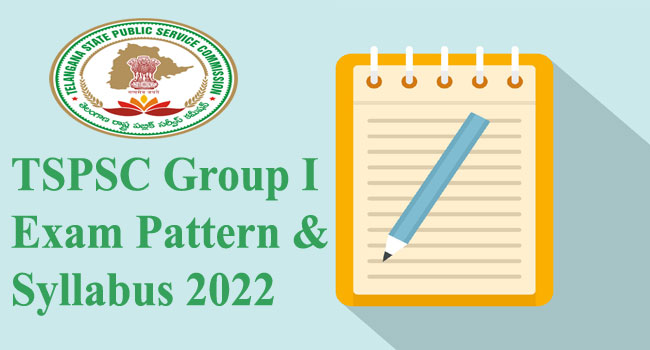TSPSC Group I Exam Pattern & Syllabus 2022

Scheme of Examination:
|
Subject |
Duration (hours) |
Max Marks |
|
Preliminary Test General Studies & Mental ability (Objective Type) 150 Questions |
2 ½ |
150 |
|
Written Examination (Main) General English (Qualifying Test) |
3 |
150 |
|
Paper-I General Essay It will have to cover the following topics 1. Contemporary Social issues and Social Problems. 2. Issues of Economic Growth and Justice 3. Dynamics of Indian Politics 4. Historical and Cultural Heritage of India 5. Developments in Science and Technology 6. Education and Human Resource Development. |
3 |
150 |
|
Paper-II – History, Culture and Geography 1. History and Culture of India, with special reference to Modern Period (1757 to 1947 A.D) 2. History and Cultural Heritage of Telangana 3. Geography of India and Telangana |
3 |
150 |
|
Paper –III – Indian Society, Constitution and Governance 1. Indian Society, Structure, Issues and Social Movements 2. Constitution of India 3. Governance |
3 |
150 |
|
Paper –IV – Economy and Development 1. Indian Economy and Development 2. Telangana Economy 3. Development and Environmental Problems |
3 |
150 |
|
Paper- V – Science & Technology and Data Interpretation 1. The role and impact of Science and Technology 2. Modern Trends in application of knowledge of Science 3. Data Interpretation and Problem Solving |
3 |
150 |
|
Paper-VI - Telangana Movement and State Formation 1. The idea of Telangana (1948-1970) 2. Mobilisational phase (1971 -1990) 3. Towards formation of Telangana State (1991-2014) |
3 |
150 |
Syllabus Group-I Services Preliminary Test
General Studies and Mental Ability
- Current Affairs – Regional, National & International.
- International Relations and Events.
- General Science; India’s Achievements in Science and Technology.
- Environmental Issues: Disaster Management- Prevention and Mitigation Strategies.
- Economic and Social Development of India.
- World Geography, Indian Geography and Geography of Telangana state.
- History and Cultural Heritage of India.
- Indian Constitution and Polity.
- Governance and Public Policy in India.
- Policies of Telangana State.
- Society, Culture, Heritage, Arts and Literature of Telangana.
- Social Exclusion: Rights issues such as Gender, Caste, Tribe, Disability etc. and inclusive policies.
- Logical Reasoning: Analytical Ability and Data Interpretation.
Written Examination (Main)
General English (Qualifying Test) (10th Class Standard)
- Spotting Errors – Spelling; Punctuation
- Fill in the blanks – Prepositions; Conjunctions; Verb tenses
- Re-writing sentences – Active and Passive voice; Direct & Reported Speech; Usage of Vocabulary
- Jumbled sentences
- Comprehension
- Précis Writing
- Expansion
- Letter Writing
Paper-I: General Essay (Candidate should write three Essays, selecting one from each Section compulsorily. Each Section contains three Questions. Each Essay carries 50 marks.)
Section-I
- Contemporary Social Issues and Social Problems.
- Issues of Economic Growth and Justice.
Section-II
- Dynamics of Indian Politics.
- Historical and Cultural Heritage of India.
Section-III
- Developments in Science and Technology.
- Education and Human Resource Development.
Paper-II: History, Culture and Geography
I. History and Culture of India, with special reference to Modern Period (1757 to 1947 A.D.)
- Early Indian Civilizations-Indus and Vedic; Emergence of Religious Movements in the sixth century BC - Jainism and Buddhism; Indo- Greek Art and Architecture – Gandhara, Mathura and Amaravathi Schools; Social and Cultural condition under the Mauryan, Satavahanas and Guptas .
- Advent of Islam and its impact on Indian Society – Nature and significance of Bhakti and Sufi Movements; Contribution of Kakatiya, and Vijayanagara rulers to Language, Literature, Art and Architecture: the contribution of Delhi Sultans and Mughals to Language, Literature, Art, Architecture and Fine Arts, Monuments; Emergence of Composite Culture in the Deccan and India.
- The Establishment of British Colonial Rule in India: Carnatic Wars , Battle of Plassey, AngloMysore, Anglo-Maratha and Anglo-Sikh Wars; Economic Impact of British Colonial Rule: Land Revenue Settlements in British India; -Commercialization of Agriculture; Rise of Landless Agrarian Labour; Famines and Poverty; De-industrialization; Decline of Traditional Crafts; Drain of Wealth; Growth of Trade and Commerce- Economic Transformation of India; Railroads, Transport and Communication Network- Telegraph and Postal Services.
- Anti – British uprisings: Tribal and Peasant revolts in the Nineteenth Century-Causes and Consequences of 1857 revolt. Factors responsible for the rise of Indian Nationalism; Rise and Growth of Socio- Religious and Anti-Caste Movements: Brahma Samaj, Arya Samaj, Aligarh Movement, Satya Shodak Samaj, Jotiba and Savithribhai Phule, Pandita Ramabai, Narayana Guru, Ayyankali, Annie Beasant; Non- Brahmin, Justice and Self-Respect Movements: Periyar, Mahatma Gandhi, Ambedkar and others.
- Three Phases of Indian Freedom Struggle, 1885-1947. The rise and growth of All India Kisan Sabha, Workers and Tribal movements; Issue of Gender and Women’s movement; Growth of Socialist and Communist Movements; Growth of Communalism; Independence and Partition of India.
II. History and Cultural Heritage of Telangana.
- History and culture of Ancient Telangana – Satavahanas, Ikshvakus and Vishnukundins; Rise and growth of Jainism and Buddhism; Socio-Cultural - Conditions- Language, Literature, Art and Architecture.
- Medeival Telangana and the emergence of composite culture - Kakatiyas and Velama kingdoms and their contribution to Socio- Cultural Development, Literature, Music, Dance, Art and Architecture; Qutub Shahis and their contribution to Telugu literature, art and architecture. Protest Movements against Kakatiyas and Qutub Shahis- Sammakka Sarakka and Sarvaipapanna
- The Establishment of Asaf Jahi Dynasty – Salar Jung Reforms and Modernization of Telangana ; Socio- Economic development under the Nizams – Land Tenures and Social System, Jagirdars, Deshmukhs etc.and Vetti– British Paramountcy and Nizam- Revolt of 1857 in Hyderabad and the role of Turre Baz Khan; Socio- Economic Development during the rule of the sixth and seventh Nizams - Growth of Railways, Transport and Communication System, Establishment of Industries, Educational Institutions – Monuments of Asaf Jahi period.
- Socio-Cultural Awaking in Telangana- Andhra Sarasvath Parishat – Literary and Library Movements; Establishment of Nizam Rashtra Andhra Jana Sangham – Andhra Mahasabha – Social Reform Movements -Brahma Samaj, Arya Samaj and Adi- Hindu and Dalit Movements, Role of Bhagyareddy Varma- Andhra Mahila Sabha and the growth of Women’s Movement. Role of Hyderabad State Congress and Vandemataram Movement.
- Peoples Movement against the Nizam’s Rule – Adivasi revolts – Ramji Gond and Kumaram Bheemu - Telangana Peasants Armed Struggle – Role of Andhra Mahasabha and the Communists –Majlis-Ittehadul-Muslimeen Party, Rajakars and Kasim Razvi – Police Action and the End of Nizam’s Rule – Integration of Hyderabad State into Indian Union
III. Geography of India and Telangana.
- India – Physical setting, Physiography, Drainage, Climate- Mechanism of Monsoon, effect of El-Nino and La-Nino, Rainfall variability- Floods and Drought, Soils, Vegetation and Wildlife Degradation and Conservation Measures. Major Minerals and Energy Resources distribution and conservation, Energy Crisis – role of non-conventional energy resources. Marine Resources – Economic significance, EEZ. Water resources – availability, problems of inter – state Water sharing, Conservation Measures.
- Agriculture and Irrigation – Major Food and Non-Food crops, Agro Climatic Regions, Green Revolution, recent trends in Agriculture; Major Irrigation Projects and Command Area Development; Industries- Major Industries - Iron and Steel, Cotton Textiles, Cement, Sugar, Automobile, IT, & Food Processing Industries, Localisation Factors, Industrial Corridors & Economic Development; Transportation: Means of Transportation, Role of Road and Rail Network in Economic Development, Highways and Express Highways; Major Ports – changing trends and direction of India’s Trade - role of WTO; Strategic location of India in the Indian Ocean; Population – distribution, growth, Demographic characteristics, Demographic dividend and transition, HDI, Population problems and Policies. Urbanisation process- Spatial pattern, growth of Megacities, problems of Urban Growth and Policies, concept of Smart Cities.
- Geographical extent of Hyderabad State and present Telangana State Physical setting, Relief, Climate, Rivers, Soils, Forest cover and Wild life–distribution, depletion and conservation. Minerals and Energy resources - Coal, Iron and Limestone distribution. Thermal and Hydro Power Projects – Problems and Prospects.
- Agriculture- Rainfed/Dry land Agriculture, Drought prone areas and Mitigation Measures. Sources of Irrigation: Canals, Tanks and Wells, Depletion of Ground Water and its conservation- Mission Kakatiya. Industries – Cement, Sugar, Pharma, Electronic, Tourism, IT, ITIR, SEZs. Handicrafts and Household Industries and their problems. Road and Rail Network distribution and role in Economic Development. Population - distribution, growth, density, demographic characteristics (sex ratio, age, literacy, etc.,) Tribal Population - distribution, problems of Tribal areas and policies for Tribal Area Development.
- Urbanisation in Telangana State, Spatio-temporal changes, Urban Growth and Migration. Evolution and phases of Urban Growth of Hyderabad, transformation from historical to modern cosmopolitan Megapolis, Primacy of Hyderabad in Telangana State, City structure, Industries and Industrial estates, urban infrastructure and transport - ORR and Metro - Problems and Planning - role of GHMC and HUDA (Metropolitan Development Plan – 2031, HMDA), Hyderabad as a Tourist Centre and Global city.
PAPER –III – Indian Society, Constitution and Governance
I. Indian Society, Structure, Issues and Social Movements
- Indian Society: Salient features, Unity in Diversity; Family, Marriage, Kinship, Caste, Tribe, Religion, Language; Rural – Urban continuum; Multi-culturalism.
- Social Exclusion and Vulnerable Groups: Scheduled Castes, Scheduled Tribes, Backward Classes, Minorities, Women, Children, Aged and Disabled.
- Social Issues: Poverty; Unemployment, Child Labour, Violence against Women; Regionalism; Communalism and Secularism; Corruption; Caste Conflicts, Problems of Agricultural Labour; Urbanization; Development and Displacement; Environmental Degradation; Sustainable Development; Population Explosion; Agrarian Distress; Migration.
- (a)Social Issues in Telangana: Vetti; Jogini and Devadasi System; Girl Child; Flourosis; Child Labour; Migrant Labour; Child Marriages. (b) Social Movements in Telangana.
- Social Policies and Programmes in India and Telangana: Policies for Women, Children, Aged and Disabled; Policies for Scheduled Castes, Scheduled Tribes, Backward Classes and Minorities; Environmental Policy; Population Policy; Policy on Education; Policy on Health; Poverty Alleviation Programmes; Welfare Schemes for Scheduled Castes, Scheduled Tribes, Backward Classes, Women, Children, Minorities, Aged and Disabled.
II. Constitution of India:
- Evolution of Indian Constitution: Role of the Drafting Committee; Constitutional Philosophy and Preamble; Salient features & Basic Structure; Amendments.
- Fundamental Rights: Nature and Scope; Expanding horizons of Fundamental Rights; Enforceability against State and others; Welfare State and Distributive Justice under the Constitution; Directive Principles of State Policy - Rule of Law and Fundamental Duties.
- System of Government: Parliamentary system, Central Government: President, Prime Minister & Council of Ministers; Parliament: Powers and Functions; State Government: Governor, Chief Minister & Council of Ministers; Legislature: Powers and Functions, Legislative Privileges.
- Judicial System in India: Supreme Court, High Courts & Administrative Tribunals; Subordinate Judiciary; Judicial Review and Judicial Activism; Independence of Judiciary and Judicial Accountability.
- Federal system: Centre-State Relations- Issues and Challenges pertaining to the Federal Structure; Local Self-Government 73rd and 74th Constitutional Amendments for sharing of powers - Panchayat Raj and Municipal Institutions; Resolution of Inter State disputes with reference to Water Disputes- Challenges of Implementation.
III. Governance:
- Governance and Good Governance, E-Governance-Applications and Models; Governance at Union level- Cabinet Secretariat, Prime Minister's Office (PMO), Central Secretariat, Ministries and Departments; Constitutional bodies-Finance Commission, Election Commission, Union Public Service Commission, Comptroller and Auditor General of India, National Human Rights Commission, National Commissions for SCs/ST/Minorities and Women; Parliamentary Committees- Estimates Committee, Public Accounts Committee, Committee on Public Undertakings.
- Governance at State and District Levels-Secretariat and Directorates and their relationships; District Administration-Role of Collector, Institutions of Rural and Urban Governance-Powers and Functions, Systems for delivery of Services; Cooperatives, State Finance Commission; Devolution of Powers and Finances-Issues and Challenges. Development Corporations for SCs, STs, B.Cs, Minorities and Disabled Welfare; Control over AdministrationLegislative, Executive and Judicial Control.
- Programmes, Agencies and Institutions working for the development of Urban and Rural Areas; People Centred Participatory Development; Poverty Alleviation Programmes; Women Empowerment and Inclusive Growth; Rights related to Health, Food Security and EducationIssues and Challenges.
- Debates on Development and Development Processes; State and Provision of Services; State and Market; Involvement of Civil Society-Community Based Organizations (CBOs) and NGOs; Self- Help Groups, (SHGs), Charities and Stakeholders, Public-Private Partnerships (PPP); Corporate Social Responsibility.
- Ethics and Values of Administration; Neutrality of Civil Services, Committed Bureaucracy, Politician and Civil Servant Relations; Citizen Charters, Gender Sensitization; Transparency and Accountability of Administration; Prevention of Corruption in Administration- Central Vigilance Commission, Central Bureau of Investigation, Lokpal, Lokayuktha, ACB and Consumer Protection Mechanisms; Application and Impact of Right to Information Act2005; Administrative Reforms.
PAPER –IV – Economy and Development
I. Indian Economy and Development:
- National Income -Concepts and Measurement of National Income- Nominal and Real Income; Structure and growth of Indian economy – Sectoral trends in National Income of India
- Poverty and Unemployment: Concepts of Poverty - Income-based Poverty, nonincome Poverty- capability approach (Human Poverty Index), Measurement of Poverty and trends in Poverty; Concepts, estimates and trends of Unemployment
- Money and Banking: Money supply, Structure of Indian Banking and non-banking financial institutions; Reforms in Banking sector; Regulation of credit by RBI
- Public Finance: Tax structure, Central and state taxes; Government expenditure in revenue and capital account; Public debt: composition- internal and external debt; Monetary Policy, Fiscal Policy; Union Budget: Budget Analysis.
- Planning in Indian economy: Objectives, Priorities, Strategies, Achievements of Five Year Plans; 12th FYP - Inclusive growth; NITI Aayog; Liberalization, Privatisation, Globalisation: Features and Implications.
II. Telangana Economy:
- Telangana economy in Hyderabad State (Agriculture, Industry and Trade); Telangana economy in United AP (1956-2014)- Deprivation and Under development; Structure and Growth of Telangana economy: Sectoral trends in GSDP ; Per capita income; Income inequalities and Poverty.
- Human resources: Demographic Structure and Transition , Demographic dividend , (sex ratio, fertility rate, mortality rates) ; Literacy and Occupation structure: Social Sector – Education and Health
- Land reforms: I generation (1947-1970) and II generation land reforms (1970 onwards)- Abolition of Intermediaries : Zamindari, Jagirdari and Inamdari -Tenancy Reforms : Land ceiling ; Land alienation in Scheduled areas ; Impact of land reforms.
- Agriculture and Allied sectors: Trends in share of crop and allied sectors in GSDP; Distribution of land holdings; Trends in Irrigation ; Problems of dry land Agriculture; Dependence on Agriculture; Cropping pattern Trends ; Trends in productivity; Agricultural Credit, Extension and Marketing; Cooperatives and Producer Companies
- Industry and Service sectors: Industrial development; Structure and growth of industrial sector, Micro Small and Medium Enterprises (MSME) sector , Revival of sick industries; Industrial infrastructure- Power; Industrial Policy of Telangana; Structure and growth of service sector; employment trends in Industry and Service sectors; Information and Communication Technology (ICT) Policy of Telangana.
III. Development and Environmental Problems:
- Environment vs Development: Definition of Environment, Environmentalism; Environmental Protection Policy, Environmental Policy Instruments.
- Natural resources: Forest resources- Commercialization of forests - Forest Acts vs Forest dwellers/ users; Water: surface water and groundwater, competing demand for water - drinking, industrial and agriculture; Land resources: competing uses of landfood, feed, fuel, and fibre; Mining and Environment; Sustainability of natural resources.
- Eco systems and Bio-diversity: Ecology and Eco-system; Food chains in Eco systems, Typology of eco system; Bio diversity and its conservation, Types of Bio diversity, threat to Bio diversity.
- Environment pollution and solid waste management, types of solid waste, factors affecting solid waste generation, impact of solid waste, recycling and reuse.
- Global Environment Issues: Climate Change, Global Warming and its impact, Sustainable Development.
PAPER- V – Science & Technology and Data Interpretation
I. The role and impact of Science and Technology.
- Classical and Emerging areas of Science & Technology : Value addition by Science & Technology, Current Science & Technology developments in India and importance of Science & Technology as an engine for National Development ; Industrial development & Urbanization.
- National Policy of Science & Technology: changes in Policy from time to time: Technology missions ICT: Basics in Computers, Robotics, Nano technology and Communication.
- Space program in India and its applications with special reference to industrial, agricultural and other rural development activities, INSAT, IRS systems, EDUSAT and Chandrayaan-1 and future programme.
- Application of Space Technology in India with references to Education, Agriculture and Industry. Climatic change, Floods, Cyclone, Tsunami, Natural and Manmade Disaster Management.
- Energy Resources: Energy demands, Indian energy scenario- hydel, thermal and nuclear. Importance of renewable resources - Solar, Wind, small/Mini/Micro hydel, Biomass, waste based, geothermal, tidal & fuel cells. Energy security - Role of Science & Technology, Bio-fuel cultivation and extraction.
II. Modern Trends in application of knowledge of Science:
- Crop Science in India; Characteristics of Plants - Crop plants, Forest species, Medicinal Aromatic plants, Useful and Harmful plants and utility for mankind.
- Concept of Biotechnology and application of genetic engineering and Stem Cell Research. Biotechnology in Agriculture (bio-fertilizers, bio - pesticides, bio- fuels, tissue culture, cloning) and Environment (Biotechnology in Environmental cleanup process)
- Food bio-technology, Food safety and Food quality standards, Food Laws and Regulations. Recent trends in organic farming and farm mechanization. Safe Drinking Water – Defluoridation and other Techniques.
- Microbial infections; Introduction to bacterial, viral, protozoal and fungal infections. Basic knowledge of infections caused by different groups of micro organisms- diarrhoea, dysentery, cholera, tuberculosis, malaria, viral infections like HIV, encephalitis, chikungunya, bird flu- preventive measures during out breaks.
- Vaccines: Introduction to immunity, Fundamental concepts in vaccination and traditional methods of vaccine production (production of DPT and Rabies vaccine), Production of modern vaccines (production of Hepatitis Vaccine).
III. Data Interpretation and Problem Solving:
- Data Analysis – Analytical Interpretation of statistical Data, Study of Graphs and Charts - Bar graphs, Line graphs and Pie- charts and drawing conclusions.
- Problems based on Tabular and Diagrammatical Data - Problems based on Probability Logical Reasoning, Analytical and Mental ability.
- Quantitative Aptitude – Number Sequences, Series, Averages, Number Systems, Ratio and Proportion, Profit and Loss.
- Time and Work, Speed -Time – Distance, Simple Interest, Analytical and Critical reasoning.
- Decision Making and Problem Solving: A duly structured situation will be presented to the candidates and they will be asked to analyze and suggest their own solution to the problem arising out of situations.
PAPER-VI - Telangana Movement and State Formation
I. The idea of Telangana (1948-1970)
1. Historical Background: Telangana as a distinctive cultural unit in Hyderabad Princely State, its geographical, cultural, socio, political and economic features- People of Telangana- castes, tribes, religion, arts, crafts, languages, dialects, fairs, festivals and important places in Telangana. Administration in Hyderabad Princely State and Administrative Reforms of Salar Jung and Origins of the issue of Mulkis-Non-Mulkis; Employment and Civil Services Rules under Mir Osman Ali Khan, VII Nizam’s Farman of 1919 and Definition of Mulki - Establishment of Nizam’s Subjects League known as the Mulki League 1935 and its Significance; Merger of Hyderabad State into Indian Union in 1948; Employment Policies under Military Rule and Vellodi,1948-1952; Violation of Mulki-Rules and Its Implications.
2. Hyderabad State in Independent India- Formation of Popular Ministry under Burgula Ramakrishna Rao and 1952 Mulki-Agitation; Demand for Employment of Local people and City College Incident- Its importance. Justice Jagan Mohan Reddy Committee Report, 1953 – Initial debates and demand for Telangana State-Reasons for the Formation of States Reorganization Commission (SRC) under Fazal Ali in 1953-Main Provisions and Recommendations of SRC-Dr. B. R. Ambedkar’s views on SRC and smaller states.
3. Formation of Andhra Pradesh, 1956: Gentlemen’s Agreement - its Provisions and Recommendations; Telangana Regional Committee, Composition and FunctionsViolation of Safeguards-Migration from Coastal Andhra Region and its Consequences; Post-1970 Development Scenario in Telangana- Agriculture, Irrigation, Power, Education, Employment, Medical and Health etc.
4. Violation of Employment and Service Rules: Origins of Telangana Agitation- Protest in Kothagudem and other places, Fast unto Death by Ravindranath; 1969 Agitation for Separate Telangana. Role of Intellectuals, Students, Employees in Jai Telangana Movement.
5. Formation of Telangana Praja Samithi and Course of Movement - the Spread of Telangana Movement- Major Events, Leaders and Personalities- All Party Accord – G.O. 36 - Suppression of Telangana Movement and its Consequences-The Eight Point and Five-Point Formulas-Implications.
II. Mobilizational Phase (1971 -1990)
- Court Judgements on Mulki Rules- Jai Andhra Movement and its Consequences- Six Point Formula 1973, and its Provisions; Article 371-D, Presidential Order, 1975-Officers (Jayabharat Reddy) Committee Report- G.O. 610 (1985); its Provisions and ViolationsReaction and Representations of Telangana Employees
- Rise and Spread of Naxalite Movement, causes and consequences - Anti-Landlord Struggles in Jagityala-Siricilla, North Telangana; Rytu-Cooli Sanghams; Alienation of Tribal Lands and Adivasi Resistance- Jal, Jungle, and Zamin.
- Rise of Regional Parties in 1980’s and Changes in the Political, Socio-Economic and Cultural fabric of Telangana- Notion of Telugu Jathi and suppression of Telangana identityExpansion of new economy in Hyderabad and other parts of Telangana; RealEstate, Contracts, Finance Companies; Film, Media and Entertainment Industry; Corporate Education and Hospitals etc; Dominant Culture and its implications for Telangana self respect, Dialect, Language and Culture.
- Liberalization and Privatisation Policies in 1990’s and their consequences - Emergence of regional disparities and imbalances in political power, administration, education, employment – Madiga Dandora and Tudum Debba movement – Agrarian crisis and decline of Handicrafts in Telangana and its impact on Telangana Society and economy.
- Quest for Telangana identity-intellectual discussions and debates- political and ideological efforts – Growth of popular unrest against regional disparities, discrimination and under development of Telangana.
III. Towards Formation of Telangana State (1991-2014)
- Public awakening and Intellectual reaction against discrimination- formation of Civil society organisation, Articulation of separate Telanagana Identity; Initial organisations raised the issues of separate Telangana; Telangana Information Trust - Telangana Aikya Vedika, Bhuvanagiri Sabha - Telangana Jana Sabha, Telangana Maha Sabha - Warangal Decleration - Telangana Vidyavanthula Vedika; etc., Efforts of Telangana Congress & BJP in highlighting the issue.
- Establishment of Telangana Rashtra Samithi in 2001, Political Realignment and Electoral Alliances in 2004 and later Phase of Telangana Movement – TRS in UPA- Girgliani Committee- Telangana Employees Joint Action Committee - Pranab Mukherjee Committee- 2009-Elections-Alliances- Telangana in Election Manifestos- The agitation against Hyderabad as Free-zone - and Demand for separate Statehood- Fast-Unto-Death by K.Chandra Shekar Rao-Formation of Political Joint Action Committee (2009)
- Role of Political Parties-TRS, Congress, B.J.P., Left parties, T.D.P., M.I.M and other political parties such as Telangana Praja Front, Telangana United Front etc., Dalit-Bahujan Sanghams and Grass roots Movement organisations - Other Joint Action Committees and popular protests- Suicides for the cause of Telangana.
- Cultural Revivalism in Telangana, other symbolic expressions in Telangana MovementLiterary forms- performing arts and other cultural expressions- writers, poets, singers, intellectuals, Artists, Journalists, Students, Employees, Advocates, Doctors, NRIs, women, Civil society groups, organised and unorganised sectors, castes, communities and other social groups in transforming the agitation into a mass movement - Intensification of Movement, Forms of Protest and Major events: Sakalajanula Samme, Non-Cooperation Movement; Million March, etc.,
- Parliamentary Process; UPA Government’s stand on Telangana- All-Party Meeting Anthony Committee- Statements on Telangana by Central Home Minister - Sri Krishna Committee Report and its Recommendations, AP Assembly and Parliamentary proceedings on Telangana, Declaration of Telangana State in Parliament, Andhra Pradesh State Reorganization Act, 2014- Elections and victory of Telangana Rashtra Samithi and the first Government of Telangana State.













